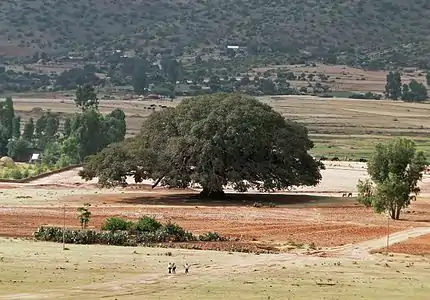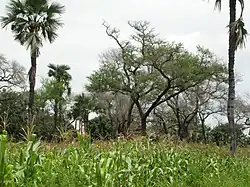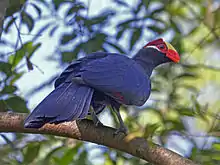| Gbele Resource Centre | |
|---|---|
| Gbele Game Production Reserve | |
 Location of Gbele Resource Centre | |
| Location | Upper West Region, Ghana |
| Nearest town | Tumu |
| Coordinates | 10°31′21″N 02°13′08″W / 10.52250°N 2.21889°W |
| Area | 565 km2 (218 sq mi)[1] |
| Operator | Forestry Commission (Wildlife Division) |
The Gbele Resource Centre or Gbele Game Production Reserve is one of the lesser known game reserves in Ghana. It is located in the Sissala West, Sissala East Municipal and Daffiama Bussie Issa districts of the Upper West Region The reserve is the fourth largest in Ghana.[2] The nearest town is Tumu, capital of the Sissala East Municipal District which is 17 kilometres to the north.[3] A total of 176 species of birds have been recorded in the reserve. The staff in the reserve are aware of an additional 18 species.[4] The reserve contains antelope, hartebeest, bushbuck, waterbuck, savannah duikers and warthogs, baboon, patas, green monkey among others. There are about 190 species of birds as well. There are nature hikes provided as well. About 30 kilometres to the north of the centre is the Gwollu Defence Wall.[5][6]
Location
The Gbele Resource Centre is located to the northeast of Wa, capital of the Upper West Region. To the west is Nadowli, Jirapa and Lawra. To the north is Nandom and Hamile . There is a village called Gbele located within the reserve.
Resettlement
In 2019, the government finalised an agreement with settlers in the park which will ensure that they had all vacated the reserve by March 2020 and moved to new housing units it had built for them. The resettlement programme began in 2011. The settlers had migrated into the reserve in search of fertile land for farming.[2]
Habitat
The topgraphy of the reserve is generally flat. The Kulpawn River which is seasonal flows from the west to the southeast. Around the Gbele village are thickets clumps consisting of the African baobab, acacia and sycamore fig trees.[7]
Flora


- African baobab (Adansonia digitata)[7]
- Faidherbia (Acacia albida)
- Sycamore fig (Ficus sycomorus)
Fauna
Gbele Resource Centre is the only wildlife reserve where the Rufous-rumped lark is known to occur and breed. It is also one of only three reserves where the Yellow-billed oxpecker is recorded.[7]
Birds:
- Black-headed weaver ( Ploceus melanocephalus)[7]
- Dorst's cisticola ( Cisticola guinea)[7]
- Gambaga flycatcher (Muscicapa gambagae)[7]
- Northern carmine bee-eater (Merops nubicus)[7]
- Red-throated bee-eater (Merops bulocki)[8]
- Rufous-rumped lark (Pinarocorys erythropygia)
- Spotted thick-knee (Burhinus capensis)[7]
- Violet turaco (Musophaga violacea)[8]
- Willcocks's honeyguide (Indicator willcocksi)[7]
- Yellow-billed oxpecker (Buphagus africanus)[7]
Animals:
Gallery
 African baobab (Adansonia digitata)
African baobab (Adansonia digitata) Faidherbia albida (Acacia albida)
Faidherbia albida (Acacia albida) Sycamore tree (Ficus sycomorus)
Sycamore tree (Ficus sycomorus) Violet turaco(Musophaga violacea)
Violet turaco(Musophaga violacea).jpg.webp) Yellow-billed Oxpecker (Buphagus africanus)
Yellow-billed Oxpecker (Buphagus africanus).jpg.webp) Roan antelope (Hippotragus equinus koba)
Roan antelope (Hippotragus equinus koba) Rufous-rumped lark (Pinarocorys erythropygia)#
Rufous-rumped lark (Pinarocorys erythropygia)#_male.jpg.webp) Waterbuck (Kobus ellipsiprymnus defassa)
Waterbuck (Kobus ellipsiprymnus defassa)
See also
References
- ↑ "CONNECTING TO OTHER PARKS IN NORTHERN GHANA". Mole National Park. Forestry Commission (Wildlife Division). Retrieved 3 June 2021.
- 1 2 "Settlers in Gbele Reserve to move out March 2020". Graphic Online. 2 June 2019. Retrieved 3 June 2021.
- 1 2 3 4 5 "Visit Ghana | Gbele Game Reserve". Visit Ghana. Ghana Tourism Authority. Retrieved 3 June 2021.
- ↑ "Important Bird Areas factsheet: Gbele Resource Reserve (summary)". www.birdlife.org. BirdLife International. Retrieved 3 June 2021.
- ↑ "Gbele Game Reserve: Wildlife in the Savannah". Jetsanza.com. 28 November 2019. Retrieved 3 June 2021.
- ↑ "Gbelle Resource Reserve". Africa Tour Operators. 2015-05-03. Retrieved 3 June 2021.
- 1 2 3 4 5 6 7 8 9 10 "BirdLife Data Zone - Important Bird Areas factsheet: Gbele Resource Reserve (text)". www.birdlife.org. BirdLife International. Retrieved 3 June 2021.
- 1 2 "BirdLife Data Zone - Important Bird Areas factsheet: Gbele Resource Reserve (data)". www.birdlife.org. BirdLife International. Retrieved 3 June 2021.